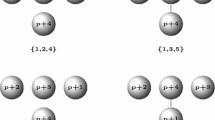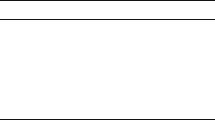Summary
A new column enumeration algorithm for solving the Set-Partitioning Problem is presented. It is not based on the staircase form of the coefficient matrix. Rather, it uses a preordering of the variables with respect to their cost of covering one row that is a supposition of a new strong lower bound concept. The enumeration process itself is organized similar to a general branch-and-bound concept. The performance of the algorithm is evaluated on the basis of a systematic comparison with different variants of the wellknown algorithms by Pierce and Garfinkel-Nemhauser. The computational experiences indicate that the new algorithm is superior for problems with moderatly dense coefficient matrices.
Zusammenfassung
In diesem Artikel wird ein neuer spaltenenumerierender Algorithmus zur Lösung des Set-Partitioning-Problems beschrieben, der nicht die übliche treppenförmige Anordnung der Koeffizientenmatrix benutzt. Das Verfahren geht vielmehr von einer Sortierung der Variablen nach aufsteigenden Kosten zur Bedeckung einer Zeile aus. Unter der Voraussetzung einer solchen Ordnung läßt sich dann eine scharfe untere Schranke berechnen. Die Enumeration selber wird ähnlich wie in einem generellen Branch-and-Bound-Verfahren vollzogen. Die Güte dieses Algorithmus wird auf der Grundlage eines systematischen Vergleichs mit verschiedenen Varianten der bekannten Verfahren von Pierce und Garfinkel-Nemhauser überprüft. Die Ergebnisse zeigen, daß der neue Algorithmus für Probleme mit mittlerer Dichte der Koeffizientenmatrix überlegen ist.
Similar content being viewed by others
References
Albers S (1977) Einsatzplanung von Flugzeugbesatzungen. Dissertation Hamburg
Arabeyre JR, Fearnley J, Steiger FC, Teather W (1969) The airline crew scheduling problem: A survey. Transp Sci 3:140–163
Balas E, Padberg MW (1972) On the set-covering problem. Oper Res 20:1152–1161
Balas E, Padberg MW (1975) On the set-covering problem: II. An algorithm for set partitioning. Oper Res 23:74–90
Balas E, Padberg MW (1976) Set partitioning: A survey. SIAM Rev 18:710–760
Balinski ML (1965) Integer programming: Methods, uses, computation. Manage Sci 12:253–313
Balinski ME, Quandt RE (1964) On an integer program for a delivery problem. Oper Res 12:300–304
Bellmore M, Ratliff HD (1971) Set covering and involutory bases. Manage Sci 18:194–206
Christofides N, Korman S (1975) A computational survey of methods for the set covering problem. Manage Sci 21:591–599
Etcheberry J (1977) The set-covering problem: A new implicit enumeration algorithm. Oper Res 25:760–772
Dundas JM (1972) United air lines' use of the IBM TPACS program. AGIFORS 12, Nathanya (Israel)
Garfinkel RS, Nemhauser GL (1969) The set-partitioning problem: Set covering with equality constraints. Oper Res 17:848–856
Garfmkel RS, Nemhauser GL (1970) Optimal political districting by implicit enumeration techniques. Manage Sci 16:B495-B508
Garfinkel RS, Nemhauser GL (1972) Integer programming. John Wiley, New York
Geoffrion AM, Marsten RE (1972) Integer programming: A frame-work and state-of-the-art survey. Manage Sci 18:465–491
Lemke CE, Salkin HM, Spielberg K (1971) Set covering by single branch enumeration with linear programming sub-problems. Oper Res 19:998–1022
Levin A (1969) Solving the airline crew scheduling problem by a land-and-doig typ algorithm. Flight transportation laboratory memo M 69-2. MIT, Boston
Marsten RE (1974) An algorithm for large set partitioning problems. Manage Sci 20:774–787
Payne WH, Radbring JR, Bogyo TP (1969) Coding the Lehmer pseudo random number generator. Commun ACM 12:85–86
Pierce JF (1968) Application of combinatorial programming to a class of all-zero-one integer programming problems. Manage Sci 15:191–209
Pierce JF, Lasky JS (1973) Improved combinatorial programming algorithms for a class of all-zero-one integer programming problems. Manage Sci 19:528–543
Rohde M (1979) Set Partitioning mit linearen Randbedingungen. OR Spektrum 1:75–87
Rubin J (1973) A technique for the solution of massive set covering problems, with application to airline crew scheduling. Transp Sci 7:34–48
Shanker RJ, Turner RE, Zoltners AA (1975) Sales territory design: An integrated approach. Manage Sci 22:309–320
Thiriez H (1969) Airline crew scheduling: A group theoretic approach. Ph.D. Dissertation. MIT, Boston
Author information
Authors and Affiliations
Rights and permissions
About this article
Cite this article
Albers, S. Implicit enumeration algorithms for the Set-Partitioning Problem. OR Spektrum 2, 23–32 (1980). https://doi.org/10.1007/BF01720155
Received:
Accepted:
Published:
Issue Date:
DOI: https://doi.org/10.1007/BF01720155




